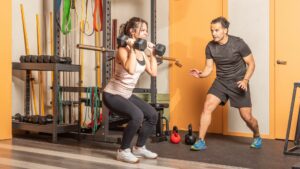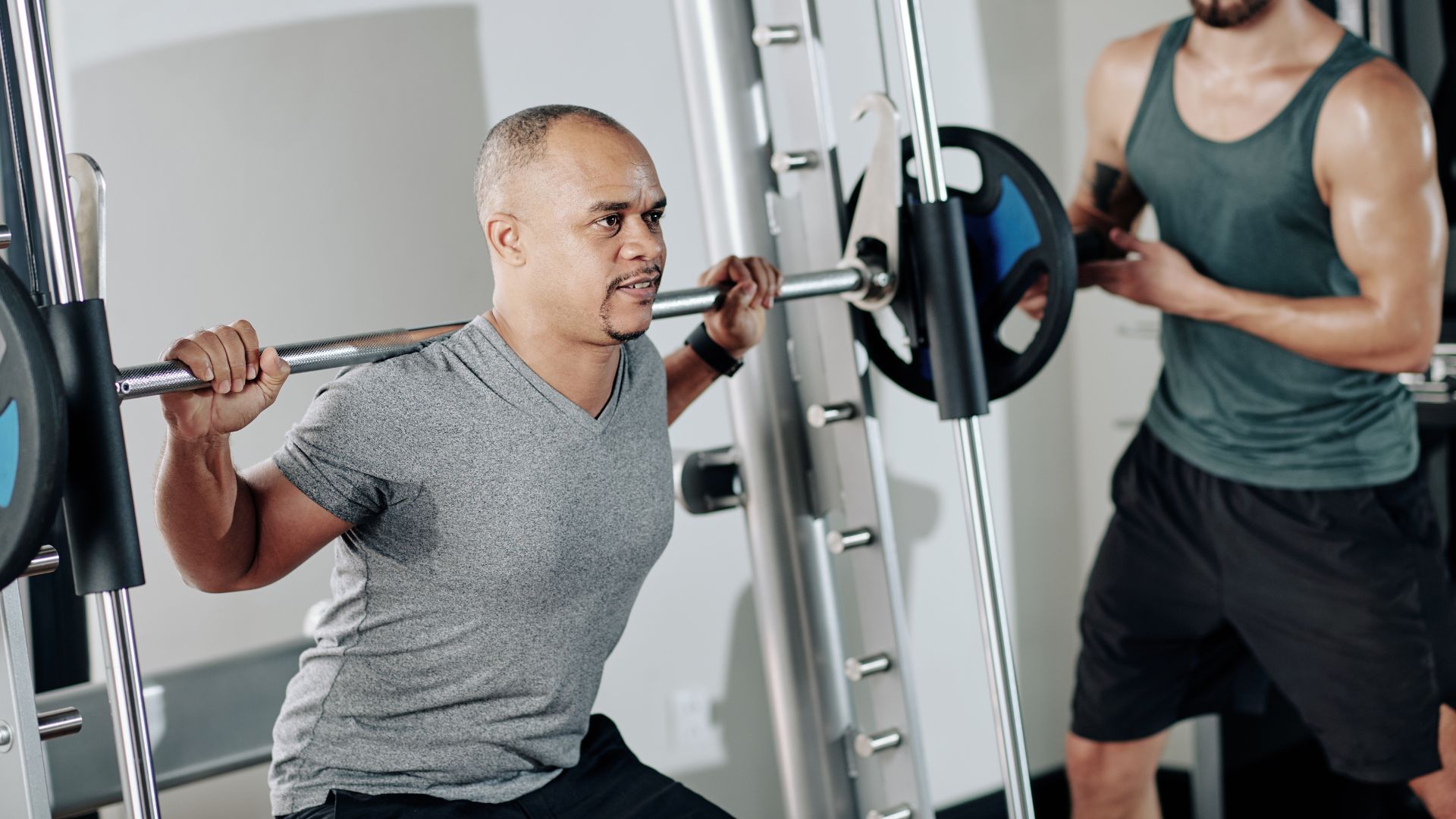Hey there, fitness enthusiasts and fellow 37-year-olds! Ever wondered how much you should be squatting at this stage of life? Well, you’re not alone.
Whether you’re new to squats or a seasoned lifter, it’s natural to have questions about your squatting goals as you navigate your late 30s.
In this blog post, we’ll explore the factors that influence your squatting capacity, offer practical insights, and provide guidance to help you set realistic expectations for a strong and healthy journey through your 30s and beyond.
So, let’s dive in and find out just how much you should be aiming to squat at 37 years old!
Understanding How Much To Be Squatting at 37 Years Old.
There’s no one-size-fits-all as to how much you should be squatting. The reason is that the amount you should be able to squat at 37 years old can vary widely depending on several factors, including your fitness level, training history, genetics, and overall health.
However, here I provide you with some general guidelines and considerations to help you determine a reasonable squatting goal for your age.
Individual Factors: Everyone is different, and age alone doesn’t determine how much you should be able to squat.
Your current strength, body composition, and training experience play a significant role in setting your squatting expectations.
Strength Standards: One way to estimate your squatting goals is to refer to strength standards, which categorize strength levels based on your body weight.
For example, for a healthy, trained male at age 37, squatting 1.5 times your body weight could be a reasonable goal. For females, 1 to 1.25 times body weight can be a target.
Training History: Your training history matters. If you’ve been consistently strength training for several years, you’re likely to have a higher squatting capacity than someone who is just starting out.
Health and Mobility: Your overall health, joint mobility, and any pre-existing injuries or limitations can impact your squatting ability.
It’s crucial to prioritize proper form and safety in your training.
Progressive Overload: Regardless of age, the key to improving your squat strength is to follow a structured training program that includes progressive overload.
Gradually increase the weight you lift over time, along with proper rest and recovery.
Consult a Trainer: For a more personalized assessment and guidance, consider working with a certified fitness trainer or coach who can evaluate your specific circumstances and set appropriate goals.
Safety First: Remember that safety is paramount. Don’t push yourself too hard, especially if you’re new to squatting or have any medical concerns.
Always warm up properly, use proper technique, and consider incorporating other leg exercises into your routine to build overall lower body strength.
In other words, there’s no one-size-fits-all answer to how much you should be squatting at 37 years old.
Your ability will depend on various factors, and it’s important to set realistic, achievable goals based on your current condition and training experience.
Safety and proper technique should always be your top priorities, and it’s advisable to seek guidance from a fitness professional if you’re unsure about your squatting goals or techniques.

Further Explanations.
Let’s dive deeper and elaborate further on all the points mentioned.
First, let’s delve deeper into the factors that influence your squatting ability and the concept of strength standards for setting goals.
Individual Factors.
Strength:
Your current strength level is a significant factor. If you’ve been consistently engaging in strength training exercises like squats, deadlifts, and bench presses, you’re likely to have developed more strength in your lower body, making it easier to squat heavier weights.
Body Composition:
Your body composition, specifically the ratio of muscle to fat, can affect your squatting ability. Muscle is denser and stronger than fat, so individuals with a higher proportion of muscle mass tend to have an advantage in lifting heavier weights.
Training Experience:
Experience matters. If you’ve been training for years, your neuromuscular system becomes more efficient at recruiting muscle fibers, which can lead to better squatting performance. Beginners may not have this advantage.
Strength Standards.
Strength standards are guidelines that help individuals set achievable strength goals based on their body weight.
Here’s a breakdown of the example strength standards I provided for a healthy, trained 37-year-old:
Healthy, Trained Male (Age 37):
A goal of squatting 1.5 times your body weight is considered reasonable. This means if you weigh 200 pounds, you would aim to squat 300 pounds (1.5 x 200).
These standards are based on the premise that, with proper training and conditioning, a male of this age and fitness level can aim for this level of strength.
Females (Age 37):
For women, a goal of squatting 1 to 1.25 times their body weight is suggested. For example, if a female weighs 150 pounds, her goal might be to squat between 150 and 187.5 pounds.
This range accounts for natural variations in individual strength levels and is considered achievable with consistent training.
Keep in mind that these strength standards are not rigid benchmarks but rather useful guidelines to help you set realistic goals and track your progress.
Achieving these standards may take time, and it’s important to prioritize proper form and gradual progression in your training to reduce the risk of injury.
Additionally, genetics also play a role in your potential strength levels. Some individuals may naturally have a higher or lower capacity for strength development.
Therefore, it’s crucial to focus on your personal progress and not compare yourself too closely to these standards, as individual variations can be significant.
Health and mobility.
Health and mobility are critical factors that can significantly influence your squatting ability. Let’s explore how these aspects impact your capacity to squat effectively and safely:
Overall Health:
General health plays a substantial role in your ability to perform squats. Chronic health conditions, such as heart problems, respiratory issues, or metabolic disorders, can affect your stamina, endurance, and overall energy levels during workouts.
Adequate nutrition and hydration are essential for providing the energy and nutrients your muscles need for optimal performance during squats.
Getting sufficient sleep and managing stress levels are crucial for recovery and maintaining the overall physical health needed for effective strength training.
Joint Mobility:
Proper joint mobility, especially in the hips, knees, and ankles, is essential for achieving the correct squatting technique. Limited mobility can lead to poor form and increase the risk of injury.
Stretching and mobility exercises targeting the lower body can improve joint flexibility. Incorporating these into your warm-up routine can help prepare your body for squats.
Pre-Existing Injuries or Limitations:
Past injuries or physical limitations can greatly affect your squatting ability. For example, a history of knee injuries might make deep squats uncomfortable or risky.
It’s crucial to work with a healthcare professional or physical therapist to assess your specific limitations and develop a training plan that accommodates them. They can provide guidance on exercises and modifications to ensure you exercise safely.
Proper Form and Safety:
Regardless of age or fitness level, prioritizing proper squatting form is paramount. Correct technique not only maximizes the effectiveness of the exercise but also minimizes the risk of injury.

Proper squat form includes maintaining a straight back, keeping your knees aligned with your toes, and lowering your body to at least parallel with the ground. Engaging your core and using a controlled motion during both the descent and ascent phases are also essential.
Using appropriate equipment, such as squat racks, safety bars, and weight belts, can enhance your safety during heavy squats.
In all this is that your overall health, joint mobility, and any pre-existing injuries or limitations can have a profound impact on your ability to squat effectively and safely.
To optimize your squatting performance and minimize the risk of injury:
- Prioritize your general health through proper nutrition, hydration, sleep, and stress management.
- Focus on improving joint mobility through stretching and mobility exercises.
- Address any pre-existing injuries or limitations with the guidance of healthcare professionals.
- Always prioritize proper squat form and safety measures during your training sessions.
- Consider working with a fitness trainer or physical therapist to tailor your squatting program to your specific needs and goals.
Let’s explore the importance of training history and the concept of progressive overload in relation to improving your squat strength:
Training History.
Your training history plays a pivotal role in your squatting capacity. If you’ve been consistently engaging in strength training for several years, you’re likely to have developed several advantages:
Muscle Adaptation:
Over time, your muscles adapt to the demands of strength training, becoming more efficient at generating force.
Neuromuscular Efficiency:
Your nervous system becomes more adept at recruiting muscle fibers, allowing you to generate more force with less effort.
Technique Mastery:
Experience allows you to refine your squatting technique, which can lead to improved efficiency and injury prevention.
Someone who is just starting out in strength training will typically have lower squatting abilities initially due to these factors.
However, with consistent and progressive training, beginners can make significant gains over time.
Progressive Overload.
Progressive overload is a fundamental principle in strength training that applies to individuals of all ages.
It involves gradually increasing the demands placed on your muscles to promote growth and strength development. Here’s how it works:
Increasing Resistance:
To squat more weight, you need to gradually increase the amount of resistance (weight) you lift.
This can be done by adding more weight plates to the barbell, using resistance bands, or progressing to more challenging squat variations.
Repetition and Sets:
You can also increase strength by performing more repetitions (reps) and sets of squats. Over time, you might increase the number of reps you perform in each set or add additional sets to your workout routine.
Frequency:
How often you squat matters too. Regularly incorporating squatting exercises into your training routine, while allowing for proper rest and recovery between sessions, is key to progressive overload.
Rest and Recovery:
Adequate rest and recovery are essential for muscle growth and strength development. Muscles need time to repair and adapt to the stress of squatting.
This includes getting enough sleep and allowing for sufficient recovery days between intense squatting sessions.
Nutrition:
Proper nutrition, including an adequate intake of protein and essential nutrients, supports muscle growth and recovery.
Variation:
Incorporating variations of squats, such as front squats, goblet squats, or pause squats, can help break plateaus and stimulate muscle growth in different ways.
In summary, regardless of your age, your training history and your ability to progressively overload your muscles are crucial for improving your squat strength.
If you’re just starting out, be patient and consistent in your training. If you have a more extensive training history, you can continue to make progress by continually challenging yourself with increasing resistance and proper programming.
Always prioritize safety, proper form, and recovery in your squat training to optimize your results.
Let’s dive into why consulting a trainer and prioritizing safety are crucial aspects of a squatting routine:
Consult a Trainer.
Personalized Assessment:
A certified fitness trainer or coach has the expertise to assess your individual circumstances.
They can evaluate your current fitness level, any past injuries or limitations, and your specific goals related to squatting.
This assessment allows for a tailored approach to your training.
Proper Technique:
Trainers can teach you the correct squatting technique from the beginning. Ensuring proper form is essential to prevent injuries and maximize the effectiveness of the exercise.
Goal Setting:
Based on your assessment, a trainer can set appropriate and realistic squatting goals for you. These goals can evolve as you progress, keeping you motivated and focused on your fitness journey.
Progress Monitoring:
Trainers can track your progress and make necessary adjustments to your training program. This helps you avoid plateaus and ensures you continue to make gains in strength and fitness.
Safety:
Trainers can provide guidance on how to safely perform squats, especially if you have any pre-existing medical conditions or concerns.
They can recommend modifications or alternative exercises if necessary.
Safety First.
Avoiding Injury:
Safety is paramount in any exercise program, and squats are no exception. Pushing yourself too hard, using improper form, or lifting too much weight can lead to injuries, especially in the lower back, knees, or hips.
A proper warm-up, including dynamic stretches, can help prepare your muscles and joints for the demands of squatting.
Proper Technique:
Using correct squatting technique is essential for safety. Proper form ensures that you distribute the load evenly across your muscles and joints, reducing the risk of injury.
Common squatting mistakes, such as rounding your back or allowing your knees to collapse inward, can lead to problems over time.
Progression:
It’s important not to rush your progress. Gradually increasing the weight you lift and listening to your body’s signals are vital for injury prevention.
Overtraining or lifting weights that are too heavy can strain your muscles and joints.
Variety:
Incorporating other leg exercises into your routine, such as lunges, leg presses, or step-ups, can help balance your leg strength and reduce the risk of overuse injuries.
A well-rounded lower body workout can enhance overall stability and strength.
Recovery:
Adequate rest and recovery are crucial for muscle repair and growth. Pushing yourself too hard without giving your body time to recover can lead to burnout and injury.
A trainer can help you structure your training program with appropriate rest periods.
In other words, consulting a certified fitness trainer or coach is a wise choice, especially if you’re new to squatting or have specific fitness goals.
Safety should always be your top priority. Proper technique, gradual progression, and attention to your body’s signals are essential for a safe and effective squatting routine.
Incorporating a well-rounded lower body workout and allowing for adequate recovery will help you build strength and minimize the risk of injury.
A concise tabular on this topic here.
Here I provide you with a concise tabular summary of the factors to consider when determining how much you should be squatting at 37 years old.
Please note that the values in the table are general guidelines and can vary based on individual factors.
| Factors to Consider | Squatting Goals at Age 37 |
|---|---|
| Individual Factors | |
| – Current Strength | Dependent on training history, but aiming for 1.5 times body weight for males and 1 to 1.25 times body weight for females can be reasonable. |
| – Body Composition | More muscle mass can contribute to higher squatting capacity. |
| – Training Experience | Experienced individuals may have higher squatting abilities. |
| Health and Mobility | |
| – Overall Health | Good health supports better squatting performance. |
| – Joint Mobility | Proper mobility is crucial for correct squat form. |
| – Pre-Existing Limitations | Past injuries or limitations should be considered and accommodated. |
| Training Principles | |
| – Progressive Overload | Gradually increasing weight, reps, or sets in training programs is key for improvement. |
| – Safety First | Prioritize proper form and safety to prevent injuries. |
| Consult a Trainer | |
| – Personalized Assessment | Trainers can assess your specific circumstances and set tailored goals. |
| – Proper Technique | They can ensure you use correct form to prevent injuries. |
| – Progress Monitoring | Trainers track progress and make adjustments for continued improvement. |
| – Safety Guidance | They provide guidance on safe squatting, especially for those with medical concerns. |
Remember that these are general guidelines, and individual variations are significant. Consulting with a fitness professional for personalized guidance is advisable for the best results and safety.
Conclusion.
In conclusion, determining how much you should be squatting at 37 years old is influenced by various factors, including your current strength, body composition, training experience, health, mobility, and adherence to training principles like progressive overload and safety.
While general guidelines suggest aiming for 1.5 times body weight for males and 1 to 1.25 times body weight for females as reasonable squatting goals, individual differences are significant.
Prioritizing safety, proper form, and personalized guidance from a fitness professional can help you set appropriate goals and work towards achieving them while minimizing the risk of injury.

Hey there, it’s Mike Rrsq, the Editor-in-Chief over at Jsquat.com, and I’m absolutely obsessed with all things squat fitness! I’ve been lucky enough to get some serious recognition for my work in this field. With a solid background in the fitness and wellness industry, I’ve been there right from the get-go, helping shape this website into what it is today.
You see, I’m not just the boss around here; I’m also a passionate contributor. I love sharing my insights through my articles, and trust me, they’re not your run-of-the-mill stuff. Each piece I write is a labor of love, filled with my expertise and real-world experience in the fitness universe. So, if you’re into fitness and looking for some inspiration, you’re in the right place!

